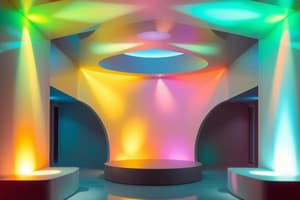Podcast
Questions and Answers
Which of the following is a type of discharge light source?
Which of the following is a type of discharge light source?
- Fluorescent (correct)
- Foot-candle
- Luminous flux
- Incandescent
The unit 'lux' is used to measure illuminance.
The unit 'lux' is used to measure illuminance.
True (A)
What is the primary usage of filters and lenses in lighting?
What is the primary usage of filters and lenses in lighting?
To modify and control light characteristics.
What is the main purpose of ambient lighting in architecture?
What is the main purpose of ambient lighting in architecture?
Directional plays of light can enhance the texture of surfaces.
Directional plays of light can enhance the texture of surfaces.
_________ is a measure of the light output of a source.
_________ is a measure of the light output of a source.
Name one factor that light influences in architectural design.
Name one factor that light influences in architectural design.
Match the following terms with their definitions:
Match the following terms with their definitions:
The case study on the Grand Mosque is located in ________.
The case study on the Grand Mosque is located in ________.
Which of the following factors does NOT affect human light perception?
Which of the following factors does NOT affect human light perception?
Match the type of lighting with its characteristic:
Match the type of lighting with its characteristic:
Stereo vision is crucial for perceiving depth in low-light conditions.
Stereo vision is crucial for perceiving depth in low-light conditions.
Which of the following statements about light is NOT true?
Which of the following statements about light is NOT true?
Name one application of lighting control systems.
Name one application of lighting control systems.
Inappropriate lighting can enhance the beauty of architectural design.
Inappropriate lighting can enhance the beauty of architectural design.
What mood can be created by altering light patterns in a space?
What mood can be created by altering light patterns in a space?
Which of the following is a principle of lighting that focuses on creating visuals for comfort and safety?
Which of the following is a principle of lighting that focuses on creating visuals for comfort and safety?
Lighting for orientation refers to the use of lighting to help people navigate through spaces.
Lighting for orientation refers to the use of lighting to help people navigate through spaces.
What is the purpose of avoiding glare in lighting design?
What is the purpose of avoiding glare in lighting design?
The _____ representation is used to abstractly depict the relationship between light and space.
The _____ representation is used to abstractly depict the relationship between light and space.
Match the following concepts with their descriptions:
Match the following concepts with their descriptions:
Which case study focuses on low light conditions in a museum setting?
Which case study focuses on low light conditions in a museum setting?
Creating drama through lighting is solely about providing sufficient light for tasks.
Creating drama through lighting is solely about providing sufficient light for tasks.
Name one factor that is considered when determining 'how much light is enough'.
Name one factor that is considered when determining 'how much light is enough'.
Flashcards
Reflection
Reflection
The process of light bouncing off a surface, changing direction but not its nature.
Mirror
Mirror
A smooth surface that reflects light, creating a clear image.
Transparency
Transparency
The amount of light that passes through a material.
Refraction
Refraction
Signup and view all the flashcards
Shadow
Shadow
Signup and view all the flashcards
Adaption
Adaption
Signup and view all the flashcards
Stereo vision
Stereo vision
Signup and view all the flashcards
Motion detection
Motion detection
Signup and view all the flashcards
Ambient Lighting
Ambient Lighting
Signup and view all the flashcards
Accent Lighting
Accent Lighting
Signup and view all the flashcards
Integrating light with architecture
Integrating light with architecture
Signup and view all the flashcards
Light and our well-being
Light and our well-being
Signup and view all the flashcards
Lighting to manipulate mood
Lighting to manipulate mood
Signup and view all the flashcards
Lighting vertical surfaces
Lighting vertical surfaces
Signup and view all the flashcards
The design process for lighting
The design process for lighting
Signup and view all the flashcards
Final focus and programming
Final focus and programming
Signup and view all the flashcards
Visual Hierarchy
Visual Hierarchy
Signup and view all the flashcards
Understanding Qualities of Natural Light
Understanding Qualities of Natural Light
Signup and view all the flashcards
Understanding Layers of Light
Understanding Layers of Light
Signup and view all the flashcards
Change and Variation
Change and Variation
Signup and view all the flashcards
Lighting for People
Lighting for People
Signup and view all the flashcards
How much light is enough?
How much light is enough?
Signup and view all the flashcards
Lighting for Comfort and Safety
Lighting for Comfort and Safety
Signup and view all the flashcards
Task Lighting
Task Lighting
Signup and view all the flashcards
Study Notes
Lighting Principles
- Lighting design is crucial to creating a strong and effective built environment
- Visual hierarchy in a space is important to guide the user's attention
- Understanding how light interacts with various materials is central to successful lighting design
Lighting for People
- Designers need to consider how humans perceive and respond to light
- Factors impacting the human experience of light include intensity, color, and other attributes
- Lighting should enhance a space for comfort and safety, especially in high-risk environments
- Lighting control should be flexible to suit various user needs
Lighting for Architecture
- Designing light for architecture involves understanding how light interacts with various surfaces and textures
- Subtle changes in light quality can significantly affect the experience of a space
- Architects and lighting designers collaborate to achieve comprehensive lighting designs
Recording and Visualizing Lighting
- Illuminance cone diagrams provide good visualizations of spotlight data
- Isolux diagrams illustrate the light distribution across a given surface
- Sketches and diagrams aid in recording and communicating lighting schemes visually
Project Communication and Completion
- Designers need to ensure that sufficient information is conveyed to clients
- Diagrams are crucial in explaining lighting systems
- Communication strategies with clients are critical for final design concepts and execution
Studying That Suits You
Use AI to generate personalized quizzes and flashcards to suit your learning preferences.





